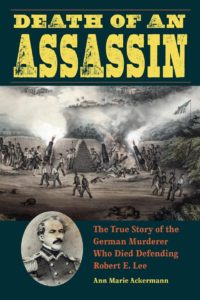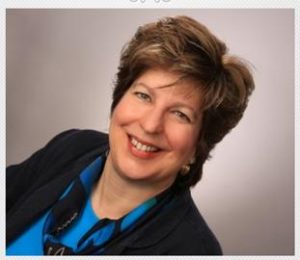 Kent State University Press released Death of an Assassin: The True Story of the German Murderer Who Died Defending Robert E. Lee on September 1 and author Ann Marie Ackermann arrives from Germany for her U.S. book tour this week. With a dozen events scheduled in Tennessee, Indiana, Wisconsin, Ohio, Pennsylvania, and Virginia, Ackermann will spend the month of October meeting and greeting readers. I’m looking forward to seeing her here in Appleton on October 10 for the Fox Cities Book Festival.
Kent State University Press released Death of an Assassin: The True Story of the German Murderer Who Died Defending Robert E. Lee on September 1 and author Ann Marie Ackermann arrives from Germany for her U.S. book tour this week. With a dozen events scheduled in Tennessee, Indiana, Wisconsin, Ohio, Pennsylvania, and Virginia, Ackermann will spend the month of October meeting and greeting readers. I’m looking forward to seeing her here in Appleton on October 10 for the Fox Cities Book Festival.
 Ann Marie Ackermann is a former American prosecutor who is a member of Bönnigheim’s historical society and Military Writers Association of America. Her work has appeared in academic journals and popular media in the U.S., U.K., and Germany. She took a few moments in her busy tour schedule to answer some questions.
Ann Marie Ackermann is a former American prosecutor who is a member of Bönnigheim’s historical society and Military Writers Association of America. Her work has appeared in academic journals and popular media in the U.S., U.K., and Germany. She took a few moments in her busy tour schedule to answer some questions.
Jill Swenson: Your historical true crime blog is fascinating to read. I’m always surprised and intrigued by the topics. How do you come up with ideas for your blog?
Ann Marie Ackermann: From my own reading in historical true crime. I avoid blood and gore and look for cases that raise interesting factual or legal issues. Was it murder or not? Can a seventeenth-century grave digger who heard cries from a coffin and is charged with burying someone alive raise a defense based on his belief in zombies? Who was the first author to use fingerprinting in a crime story? Why were public executions so popular in centuries gone by? How old of a grave can a cadaver dog find?
Occasionally I stray from true crime to write about the Civil War or German culture. Mark Twain in Germany is one of my favorite topics.
Jill Swenson: And how long does it take you to research and write a blog post?
Ann Marie Ackermann: That depends. I like to offer something original, and that requires research. If my post is based on a book I’ve read, it might go quickly, but sometimes I have to research before I write and that might take a day.
Jill Swenson: You’ve been blogging since August of 2014. Which of your blog posts have been the most popular?
 Ann Marie Ackermann: Here are the links to three of the most popular.
Ann Marie Ackermann: Here are the links to three of the most popular.
Escaping a Serial Killer: What Science Says About Victim Strategy
Mary Todd Lincoln’s Castle Ghost in Germany
Dr. Gudden’s Death Mask as a New Clue in the Death of Bavaria’s King Ludwig II
One of my all-time favorites is Archaeology Dogs: Cadaver Dogs on a 700 BC Site. Who would have ever thought cadaver dogs can find graves that old?
Jill Swenson: Can you describe the importance of your blog to your path to publishing?
Ann Marie Ackermann: Shortly after I started blogging I received an Email from the acquisition editor at Kent State University Press. She had discovered my blog, read about my work in progress, and was interested. I was thrilled because I had already had my eyes on Kent State as a potential publisher.
Swenson Book Development helped me put together a book proposal. I couldn’t have done it without your help. I simply didn’t know what a book proposal should look like. But your advice hit the mark: The Press accepted it right away. I never got a rejection for this project!
Jill Swenson: Blogging is an effective method for pulling people to your writing. I love that it pulled in the editor at Kent State University Press and solicited an invitation to submit. You’re the only author I know who has not received a single rejection letter from an acquisitions editor. There’s many reasons a publisher would be interested in this work. Not the least of which is breaking new ground with your historical research. Your new book suggests the use of forensic ballistics came much earlier than other scholars have assumed. Can you tell us how you discovered this in your research?
Ann Marie Ackermann: The investigator made two notes to the file about test-firing buckshot with suspect rifle so he could compare the striations on the shot with the striations on the shot taken from the victim’s body at autopsy. Usually a shotgun is used to fire shot, but in this case, the murderer used a rifle. The investigator could eliminate a suspect weapon. This was fifty years before forensic ballistics was supposedly invented in France!
I could hardly believe what I was reading in the 1835 investigative file and brought it to the attention of the Baden-Württemberg state police. A ballistics technician there test fired buckshot in an attempt to replicate the conditions of the murder. He came to the conclusion the striations on the buckshot were sufficient for the investigator to have reached his conclusions. That underscores my German hometown’s status as the birthplace of forensic ballistics. As I like to tell my audience in my crime scene tours, we just scored a goal against France.
Jill Swenson: How did ballistic forensics help solve this cold case?
Ann Marie Ackermann: It helped eliminate an innocent suspect, but it didn’t help solve it. Incredibly, the solution came thirty-seven years later in a letter from Washington, DC. That made it nineteenth-century Germany’s coldest case ever solved.
Jill Swenson: The German murderer died defending Robert E. Lee. He had fled Germany to avoid prosecution and enlisted in Pennsylvania. Robert E. Lee is a name most Americans associate with the Civil War. But this happened at the Siege of Veracruz in the Mexican-American War in 1847. What did you discover about German immigrants and their participation in our armed forces?
 Ann Marie Ackermann: Many German immigrants enlisted in the military to prove their allegiance to their new country. Philadelphia had a huge German population, and when the Mexican-American War broke out in 1846, the city boasted three German militia companies. One of them, the Washington Light Infantry, became the city’s first company to volunteer for the war. It served as Company E in the 1st Pennsylvania Regiment.
Ann Marie Ackermann: Many German immigrants enlisted in the military to prove their allegiance to their new country. Philadelphia had a huge German population, and when the Mexican-American War broke out in 1846, the city boasted three German militia companies. One of them, the Washington Light Infantry, became the city’s first company to volunteer for the war. It served as Company E in the 1st Pennsylvania Regiment.
Robert E. Lee directed the fire at a naval battery at the Siege of Veracruz, his first battle. Company E defended the battery and the assassin practically died at Lee’s feet. Lee was so impressed with him he wrote a letter home deifying the man. He certainly didn’t know the man’s criminal background. This story would have shocked him.
Jill Swenson: The German falsely accused of the mayor’s murder also immigrated to America. What happened to him?
Ann Marie Ackermann: That man, Frederick Rupp, ended up becoming the man who solved the case! And he didn’t just make up the story to clear his name as an old man. A German forester found corroborating evidence in the forestry archives and based on that, the prosecutor closed the case as solved.
Unfortunately, Rupp never received the reward the city of Bönnigheim had issued in 1835 for information leading to the identification of the assassin. The current mayor would like to pay it, 182 years later, to Rupp’s descendants. I hope to be able to announce a reward presentation in the U.S. next year.
Jill Swenson: That would make for a wonderful return trip. You can meet Ann Marie Ackermann at one of the following events scheduled for her book tour here in the U.S.
October 3, 2017, 6 pm, Bartlett Tennessee: Book chat with United Daughters of the Confederacy, Gayoso 2423 Chapter, Grace Presbyterian Church, 6671 Yale Road.
October 8, 2017, 2:30 pm, Layfayette, Indiana: Book reading at Follett’s Bookstore on the Purdue University campus, 1400 W. State St.
October 10, 2017, 3 pm, Appleton, Wisconsin: Presentation, Appleton Public Library, 225 N. Oneida St.
October 12, 2017, 12 pm, Kenosha, Wisconsin: Book chat and signing, The Civil War Museum, 5400 First Avenue.
October 14, 2017, 3 pm, Wauwatosa, Wisconsin: Book chat and signing hosted by Goethe House Wisconsin, Wauwatosa Public Library, 7635 West North Ave.
October 21, 2017, Kent State, Ohio: Author reading, TBA.
October 24, 2017, 6:30 pm, Philadelphia, Pennsylvania: Presentation at the German Society of Pennsylvania, 611 Spring Garden St.
October 25, 2017, 4 pm, Philadelphia, Pennsylvania: Lecture for the Temple Uniersity German Department and Temple University German Society.
October 26, 2017, 6:30 pm, Philadelphia, Pennsylvania: Workshop and discussion at the Historical Society of Pennsylvania, 1200 Locust St.
November 3, 2017, 12 pm, Richmond, Virginia: Book chat and signing, American Civil War Museum, 1201 E. Clay St.
November 4, 2017, 2-4 pm, Stratford Hall, Virginia: Book signing in the gift shop.
November 5, 2017, 3 pm, Petersburg, Virginia: Book chat and signing, National Museum of the Civil War Soldier, 6125 Boydton Plank Rd.

Thanks so much, Jill, for this wonderful interview!